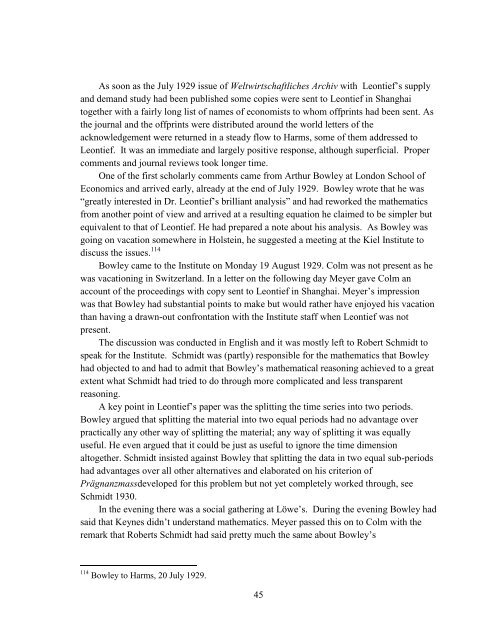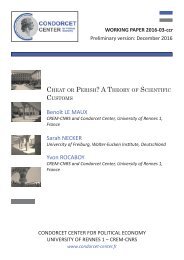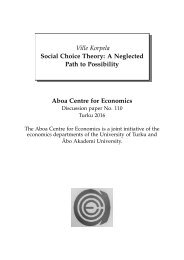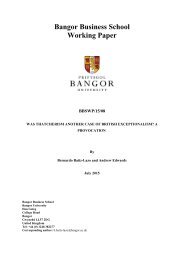MEMORANDUM
n?u=RePEc:hhs:osloec:2016_018&r=hpe
n?u=RePEc:hhs:osloec:2016_018&r=hpe
Create successful ePaper yourself
Turn your PDF publications into a flip-book with our unique Google optimized e-Paper software.
As soon as the July 1929 issue of Weltwirtschaftliches Archiv with Leontief’s supply<br />
and demand study had been published some copies were sent to Leontief in Shanghai<br />
together with a fairly long list of names of economists to whom offprints had been sent. As<br />
the journal and the offprints were distributed around the world letters of the<br />
acknowledgement were returned in a steady flow to Harms, some of them addressed to<br />
Leontief. It was an immediate and largely positive response, although superficial. Proper<br />
comments and journal reviews took longer time.<br />
One of the first scholarly comments came from Arthur Bowley at London School of<br />
Economics and arrived early, already at the end of July 1929. Bowley wrote that he was<br />
“greatly interested in Dr. Leontief’s brilliant analysis” and had reworked the mathematics<br />
from another point of view and arrived at a resulting equation he claimed to be simpler but<br />
equivalent to that of Leontief. He had prepared a note about his analysis. As Bowley was<br />
going on vacation somewhere in Holstein, he suggested a meeting at the Kiel Institute to<br />
discuss the issues. 114<br />
Bowley came to the Institute on Monday 19 August 1929. Colm was not present as he<br />
was vacationing in Switzerland. In a letter on the following day Meyer gave Colm an<br />
account of the proceedings with copy sent to Leontief in Shanghai. Meyer’s impression<br />
was that Bowley had substantial points to make but would rather have enjoyed his vacation<br />
than having a drawn-out confrontation with the Institute staff when Leontief was not<br />
present.<br />
The discussion was conducted in English and it was mostly left to Robert Schmidt to<br />
speak for the Institute. Schmidt was (partly) responsible for the mathematics that Bowley<br />
had objected to and had to admit that Bowley’s mathematical reasoning achieved to a great<br />
extent what Schmidt had tried to do through more complicated and less transparent<br />
reasoning.<br />
A key point in Leontief’s paper was the splitting the time series into two periods.<br />
Bowley argued that splitting the material into two equal periods had no advantage over<br />
practically any other way of splitting the material; any way of splitting it was equally<br />
useful. He even argued that it could be just as useful to ignore the time dimension<br />
altogether. Schmidt insisted against Bowley that splitting the data in two equal sub-periods<br />
had advantages over all other alternatives and elaborated on his criterion of<br />
Prägnanzmassdeveloped for this problem but not yet completely worked through, see<br />
Schmidt 1930.<br />
In the evening there was a social gathering at Löwe’s. During the evening Bowley had<br />
said that Keynes didn’t understand mathematics. Meyer passed this on to Colm with the<br />
remark that Roberts Schmidt had said pretty much the same about Bowley’s<br />
114 Bowley to Harms, 20 July 1929.<br />
45





